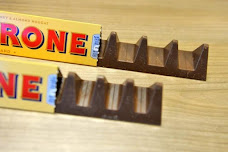Shrink (pronounced shringk)
(1) To
draw back, as in retreat or avoidance; to shrink from danger; to shrink from
contact.
(2) To
contract or lessen in size, as from exposure to conditions of temperature or
moisture; to become reduced in extent or scope.
(3) A slang
term for a psychotherapist, psychiatrist, or psychoanalyst (also (rarely) as shrinker
and (historically) as head shrinker.
(4) In economics, as "shrinkflation" (the construct being shrink + (in)flation), a term describing the tactic of reducing the volume of a product (usually in the same packaging) while maintaining the price, thus an attempt to conceal the increase in the unit cost.
Pre 900: From the Middle English schrinken, from the Old English scrincan (to draw in the limbs, contract, shrivel up; wither, pine away (the past tense scranc, the past participle scruncen)), from the Proto-Germanic skrink and related to the Old Norse skrokkr (torso) & hrukka (a crease); cognate with Middle Dutch schrinken, the Old Swedish skrunkin (wrinkled), the Swedish skrynka (to shrink) & the Norwegian & Icelandic skrukka (old shrunken woman). Root was probably the Proto-Germanic skrinkwaną from skrink-, probably from the primitive Indo-European sker- (to turn, bend). Shrink is a noun & verb, shrinker & shrinkage are nouns, shrinking is a verb & adjective, shrinkable is an adjective and shrinkingly is an adverb; the noun plural is shrinks. The used derived forms are shrank (noun & verb) and shrunk (verb & adjective).
Shrink operated originally with the causal shrench (in the manner of drink/drench). The sense of "become reduced in size" emerged in the late thirteenth century, the meaning "draw back, recoil" attested since the early fourteenth, the speculation being it was suggested by the behavior of snails. The transitive sense, "cause to shrink" is also from the late 1300s. The noun shrinkage (act or fact of shrinking) dates from 1713 and was derived from the verb whereas the meaning "amount by which something has shrunk" wasn’t used until 1862. The US slang for psychiatrists dates (in some form) from 1950 and shrink-wrap is from 1961, having replaced an earlier (1959) trade-name (shrinking-wrap) which never caught on. In idiomatic use, "shrinking" often appears to suggest a quality of shyness or timidity. The best known term is "shrinking violet" (a shy or timid person, who avoids contact with others) which emerged in the mid-nineteenth century, adopting the recently coined use in botany describing the violet (genus Viola) flower and plant. In the popular imagination, a shrinking violet is a delicate, waif-like creature.
Madness and the Profession
The original use of “head-shrinker” was to describe members of the Jivaro tribe of Amazonia who preserved the heads of their enemies by stripping the skin from the skull, resulting in a shrunken mummified remnant the size of a fist. Apparently an ancient practice, the term in this anthropological sense was first recorded in 1926 and it wasn’t until 1950 when it was documented that “head-shrinker” had become Hollywood slang for a psychiatrist. Popular culture adopted the sense. It was used in the film Rebel Without a Cause (1955), by SF writer Robert Heinlein (1907-1988) in Time For The Stars (1956) and was heard on Broadway in West Side Story (1957). The first recorded use of “shrink” in this context was by Thomas Pynchon (b 1937) in his novel The Crying of Lot 49 (1965) although it’s not known if this was an invention by the author or an adoption of existing slang, many sources suggesting there exists anecdotal evidence to suggest the latter.
Nor has it ever been clear why “head shrinker” or the derived “shrink” became connected with psychiatry, the most common speculation being that the discipline, and especially psychoanalysis, was perceived to be most concerned with the shrinking of swollen egos, a perhaps not unjustified assumption in the show-business circles which provided a goodly percentage of the patients. It may hint also at the not wholly universal acceptance of psychiatry as a legitimate speciality within medicine until well into the twentieth century (by which time psychiatrist had replaced alienist). It was only with advances in diagnostic neurology and the increasing effectiveness of psychoactive drugs that psychiatry began to enjoy its current respectability within the profession.
The famous Toblerone chocolate bar is manufactured in Bern, Switzerland by Mondelez International and noted for its shape: a series of triangular prisms sitting atop an elongated base. In 2016, the company reduced the volume of chocolate in some bars by increasing the gap between the distinctive triangles, thus cutting the net weight by about 10% while using the existing packaging. It was a cost cutting exercise which lowered not only the cost of production but also some transportation fees (in those situations where freight charges were weight-based). The RRP (recommended retail price) was unchanged. The trick was not well-received in the market and within two years the prisims were moved back to their original positions, forcing the company to adopt other techniques such as moving some production to countries with lower labor costs.



No comments:
Post a Comment